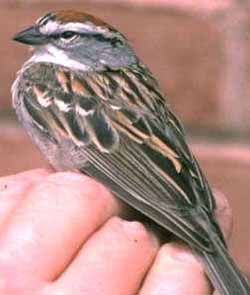Deconstructing Birdsong

The complex chirping and warbling of a bird’s song may be the product of a relatively simple circuit in its brain. Researchers publishing in the 31 December print issue of PRL modeled a part of the bird brain that can generate diverse song elements. They found that a single arrangement of cells showed behavior complex enough to produce much of the variety in a sparrow’s tune.
Songbirds aren’t born knowing how to sing. They learn to croon by memorizing and refining a template song, much as human children acquire speech, so some researchers hope to learn about human communication by studying birdsongs. They have already mapped out the sections of the brain responsible for birdsong and have shown how the bird vocal organ, or syrinx, operates. Flowing air rattles two adjacent flaps of muscle in the syrinx, producing sound. Rodrigo Laje and Gabriel Mindlin of the University of Buenos Aires and their colleagues found that cyclic changes in the air flow and flap tension in the syrinx can produce a variety of song elements, or syllables. The phase difference between the two cycles determines the qualities of the resulting song element.
Now Laje and Mindlin have set out to determine how the electrical firings of a set of brain cells generates a precise sequence of phase differences. They designed a mathematical model patterned after a region in the bird brain called the robust nucleus of the archistriatum, where the phase difference first appears. The model consists of three groups of a few cells each. Each group receives electrical input from a higher brain region. One group excites nerve cells connected to the syrinx muscles; a second activates the lungs. Cyclic behavior emerges because the first two groups also stimulate the third group, whose electrical signals inhibit the first two. When the excitatory groups shut down from this inhibition, the stimulus for the inhibitory group goes away, thus allowing the first two to begin firing again after some time interval.
Varying the average number of electrical pulses sent to the inhibitory group from the higher brain center moved the system through a set of attractors, or locked-in patterns. By combining a specific sequence of inputs with their previous physical model of the syrinx, Laje and Mindlin could reproduce three of four syllables in the recorded chirping of a sparrow. Mindlin says they didn’t expect to get so much mileage from this single model. “We thought we would need a different architecture for each syllable.”
“This is a perfect example of complexity arising from simplicity, thanks to nonlinear dynamics,” says Dante Chialvo of the University of California, Los Angeles, physiology department. The model has “the right neural stuff,” he says, meaning that it’s based on biological experiments and not conjured up to fit the theory.
Mindlin says they plan to begin adding brain regions associated with learning to the model in hopes of eventually creating a virtual bird brain. He and his collaborators run a risk with this kind of work, he says, because “you don’t know how many details you’re overlooking.” But he adds that the potential payoff is worth the risk.
–JR Minkel
JR Minkel is a freelance science writer in New York City.


